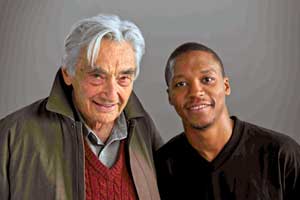Howard Zinn’s work: a weapon in the class struggle
By
Shelley Ettinger
Published Feb 4, 2010 9:54 PM
On occasion someone makes such a significant contribution to the cause that the
work speaks for itself and, assessed objectively, functions as a weapon in the
class struggle.
|
Howard Zinn and recording artist Lupe Fiasco.
Photo: Steven Faulkner Moye
|
Such an occasion was the life and such a contribution was the work of Howard
Zinn.
Zinn, who died on Jan. 27 at age 87, was called “the people’s
historian.” Everybody knew who “the people” he strove to
serve were: the working class and oppressed nationalities. This is why so many
worldwide are mourning his death.
Howard Zinn was best known for his groundbreaking study first published in
1980, “A People’s History of the United States:
1492-Present.” From its opening chapter, titled “Columbus, the
Indians, and Human Progress,” this book announced itself as something new
and different.
This was history recounted from an unaccustomed perspective. Unlike virtually
every other telling of U.S. history, either academic or popular, and most
strikingly unlike the standard textbooks used in schools across the country,
“A People’s History” was unabashedly on the side of the
masses of people — that is, the workers and oppressed.
The conventional version had claimed to be objective. Actually, it skewed the
whole sweep of history. In the telling that was fed to generation upon
generation of schoolchildren, the invaders, exploiters and oppressors were
portrayed as heroes: inventors, explorers, adventurers, saviors.
Colonial occupations and imperialist wars were depicted as noble
self-sacrificing endeavors by an enlightened, civilizing force. Technological
development, scientific innovation, societal advances were all the result of
impressive strokes of genius by individual Great White Men.
The vast majority of humanity was nowhere to be seen. Not as actors, not as
creators, not as drivers of the engine of history. Not even, for the most part,
as oppressed by the social and economic forces these standard histories
uniformly applauded as natural, positive developments. For example, the
trans-Atlantic slave trade was generally treated as cursorily as possible; the
central role of slave labor in the creation and enrichment of U.S. capitalism
was mentioned not at all.
Neither was the other project, the project that along with the system of
chattel slavery is the most important fact of early U.S. history: the theft of
the lands and genocide of the Indigenous nations of North America.
This was the landscape of history. Then came Howard Zinn.
What he did, first and foremost, was strip the mantle of impartiality from
those other histories. Every telling is biased, he said. My bias is on the side
of those who until now have been made invisible. Then he proceeded to bring
them onto the page.
The Native peoples, fighting to defend their lands and their lives. The
Africans shackled and enslaved — and rebelling. The immigrants shivering
in tenements, and the workers fighting for unions. The women demanding equal
rights.
These were the heroes of Howard Zinn’s history. And history has never
been the same.
Bourgeois historians still constitute the majority of those whose works are
published. They are still considered “mainstream” while historians
in Zinn’s tradition are dismissed as “radical.” But ever
since the first edition of “A People’s History” was
published, an alternative has been available.
Zinn was not the first or only historian to tell the class truth. There are
excellent explicit Marxist analyses that deserve to be widely read. But
Zinn’s works, because of their uniquely popular character and the way
they passed from hand to hand, played a role like few other books in our time.
Articles copyright 1995-2012 Workers World.
Verbatim copying and distribution of this entire article is permitted in any medium without royalty provided this notice is preserved.
Workers World, 55 W. 17 St., NY, NY 10011
Email:
ww@workers.org
Subscribe
wwnews-subscribe@workersworld.net
Support independent news
DONATE


